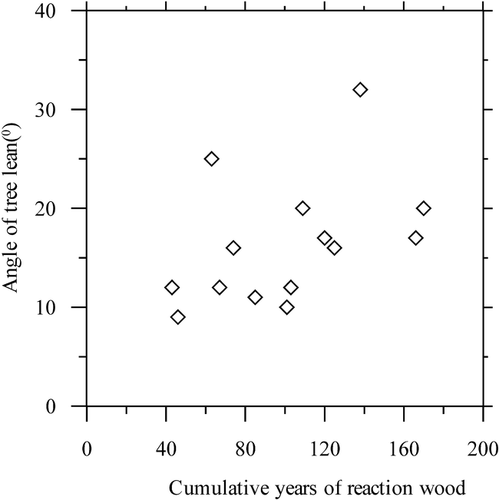Abstract
Ice wedges are common in the Mackenzie Delta, although troughs may be filled by sediments and obscured by growth of vegetation. At four sites in eastern Mackenzie Delta, over 85% of the trees within 1 m of ice-wedge troughs leaned towards these troughs. The mean angle of lean was 12° from the vertical, with some trees leaning by more than 25°. The angle of tree tilt varied inversely with distance from the ice-wedge trough and most of the trees over 1 m from an adjacent trough leaned away from the ice-wedge. Trees near the troughs are susceptible to toppling because their root systems trail away from the troughs. Reaction-wood rings in cross-sectional disks from trees leaning towards troughs indicated that progressive tilting has been sustained for decades to centuries. Long-term rates of tree tilting are estimated to be between 0.1 and 0.4° a−1. Progressive, unidirectional tilting may eventually destroy the spruce trees. In Mackenzie Delta, where forest fire is infrequent, earth movements associated with ice-wedge polygons may be one mechanism driving forest change in old-growth stands.
Introduction
Ice wedges are widely distributed in most nonbedrock areas of continuous permafrost, and the boreal forest and taiga of northern Alaska, central Yukon and Mackenzie River valley (CitationMackay, 1963; CitationPéwé, 1966; CitationMackay and Mathews, 1973; CitationBurn, 1990; CitationKotler and Burn, 2000). Ice-wedge growth occurs due to thermal-contraction cracking of the ground in winter and the infilling of cracks in spring with meltwater. Freezing of the meltwater enlarges the wedges (CitationMackay, 1989). Characteristically, the ground adjacent to ice wedges deforms to accommodate the increase in volume of the ice wedge () (CitationMackay, 1980, Citation2000). In some cases, ice wedges currently south of treeline developed when winter temperatures were colder (CitationPéwé, 1966; CitationBurn, 1990) or there was less snow cover. For example, in a boreal peatland south of Inuvik, ice wedges do not crack under current winter conditions because of snow accumulation at the site (CitationMackay, 1992, Citation1993). The surface expression of an ice-wedge network is a polygonal landscape (CitationMackay, 2000). The polygons are outlined by troughs above ice wedges, with ridges less than 0.5 m high, commonly on either side of the wedge (). Ridge formation associated with low-centered polygons has been attributed to lateral thrusting by growing ice wedges (CitationMackay, 1980, Citation1990), peat growth, injection ice (CitationMackay, 2000), and lateral compression which squeezes both the ground and ice-wedge ice resulting in the upward deformation of soils adjacent to the growing ice wedge () (CitationMackay, 1990; CitationMackay and Burn, 2002).
Thermally-induced seasonal movements of the active layer and subjacent permafrost (CitationLachenbruch, 1962) have been studied at ice-wedge polygons near the western Arctic coast of Canada and at a boreal peatland south of Inuvik by CitationJ. R. Mackay (1980, Citation1993, Citation1995, Citation2000), who has shown that in winter, thermal contraction of the active layer and upper part of permafrost is towards the polygon centers, but displacement at the polygon center is constrained by inward movements from opposite directions. In summer, when the ground expands, movement is radially outward towards the ice-wedge troughs where the movement is unconstrained (CitationLachenbruch, 1962; CitationMackay, 2000). The rate of radially outward movement is greatest near the ground surface and decreases with depth. Over several years, a small net transport of active-layer materials into ice-wedge troughs () has caused benchmarks and semiflexible tubes anchored in permafrost to lean in the direction of the adjacent troughs, irrespective of the frequency of ice-wedge cracking (CitationMackay, 1980, Citation1993, Citation1995, Citation2000; CitationMackay and Burn, 2002). The transport of active-layer materials reported by CitationMackay (2000) was greatest on ridges adjacent to ice-wedge troughs where movements of 0.4 to 0.6 cm a−1 were estimated.
The deformation of earth materials adjacent to ice wedges () and transport of active-layer materials towards ice-wedge troughs () raises the possibility that trees growing in ice-wedge polygons may respond to these movements (CitationMackay, 1980, Citation2000, p.65, item 17; CitationMackay and Burn, 2002). The purposes of this paper are to describe the tilt characteristics of spruce trees growing in polygonal terrain in Mackenzie Delta and to investigate the long-term movement of these trees.
Mackenzie Delta and Study Sites
The Mackenzie Delta, in northwestern N.W.T., is about 150 km long and up to 60 km wide. The Delta consists of an intricate network of shifting channels and thousands of lakes of varying size and origin (CitationMackay, 1963). The thermal effect of water bodies and the shifting nature of the channels affect the distribution and thickness of permafrost (CitationSmith, 1976). Ground-ice investigations indicate that segregated ice is concentrated in the upper 2 to 3 m of alluvial sediments (CitationPihlainen and Johnston, 1954). South of treeline, ice wedges dissect surfaces of the Delta plain colonized by spruce forests () (CitationMackay, 1963, Fig. 28). Sedimentation and aggradation of the permafrost table cause these wedges to grow upwards (CitationMackay, 1990), but deposition of alluvium and vegetative change obscure the polygons, so that, on the ground, the troughs are often difficult to detect.
In Mackenzie Delta, white spruce (Picea glauca) extends relatively far north and occupies elevated surfaces throughout much of the central and southern Delta (CitationGill, 1975; CitationPearce et al., 1988). White spruce/alder–bearberry (Picea/Alnus–Arctostaphylos) associations with mature trees up to 250 yr old colonize regularly flooded surfaces of the Delta plain (CitationPearce et al., 1988). Willow is also a dominant species in the understory of these forests. In these areas, the trees are vigorous and straight and the underlying permafrost is ice-poor (CitationKokelj and Burn, 2003).
White spruce/feathermoss (Picea/Hylocomium) communities replace the spruce/alder-bearberry forests as surfaces aggrade and flooding and sedimentation rates decline (CitationPearce et al., 1988). The development of a moss cover modifies ground thermal properties causing the permafrost table to rise (CitationSmith, 1975). The volumetric ice content of the underlying permafrost is 15 to 40% (CitationKokelj and Burn, 2003). Many spruce trees in these stands are between 250 and 400 yr old (CitationPearce et al., 1988). Although the trunk and root systems of most trees are anchored in permafrost (CitationGill, 1975), commonly the trees are leaning and deadfall is abundant, suggesting that the tilted trees eventually topple or break (). White spruce/crowberry–lichen (Picea/Empetrum–Cladina) communities with stunted spruce trees leaning in no consistent direction, underlain by high ice content permafrost (>35%), occupy surfaces raised above the level of spring flooding (CitationPearce et al., 1988, CitationKokelj and Burn, 2003). Fire has a dominant ecological role in the subarctic boreal forest (CitationBlack and Bliss, 1978, CitationLandhäusser and Wein, 1993), but natural occurrence of wildfire in the Delta is rare because convective activity above the Delta is reduced by abundant evaporation. The aerial extent of burning is restricted by the large number of channels and lakes.
In this paper, ice-wedge networks and overlying spruce forests are considered from four spruce/feathermoss forest sites (Sites 1 to 4) on flat, well-drained silty alluvial surfaces in eastern Mackenzie Delta (). The polygons investigated were low-centered features, whose troughs were commonly obscured by mosses and deadfall. The troughs were between 0.3 and 0.8 m wide, and ridge to trough relief was generally less than 30 cm. Trunk cross-sections for analysis of reaction wood were obtained from Sites 1–3 and from Site 5, a spruce/crowberry-lichen community north of Inuvik.
Field and Laboratory Methods
All white spruce trees growing within 5 m of discernible trough networks were mapped at four sites in eastern Mackenzie Delta during the summers of 2000 to 2002 (). Tree height, circumference at breast height, tilt at 1 m height, orientation of tilt, and distance from the base of the trunk to the ice-wedge trough were recorded for each tree. Where troughs were subtle, the presence of wedge ice was verified by drilling, with samples collected in a 5-cm-diameter core barrel. Additional observations of leaning trees in polygonal terrain were also made throughout eastern Mackenzie Delta in the summers of 2000 and 2001 ().
A total of 14 trunk cross-sections were obtained from tilted trees growing adjacent to ice wedges (Sites 1–3, 5) to examine the tree rings for reaction wood and to investigate long-term movements of the trees (CitationZoltai, 1975). In coniferous species, reaction wood is produced on the side subjected to compression, or the leaning side of the tree (CitationZoltai, 1975). In cross-section, reaction-wood rings are characterized by an eccentric crescent of dark, dense wood (). According to CitationSchroder (1978) single, abrupt, inclination events induce easily recognizable changes of normal wood to reaction wood, but gradual or long-term multiple inclinations produce compound trunk curvature and complex reaction wood with unclear initiation dates.
Six trees were obtained from Site 1, five from Sites 2 and 3 and three from Site 5. Trees were not felled at Site 4, which was adjacent to a developed area. Tree disks were sanded and rings were counted under 10 to 20 times magnification. Growth rings provided the age of the tree, while reaction-wood rings indicated the time of perturbation, and the duration and orientation of leaning (CitationZoltai and Tarnocai, 1974). Within the tree-ring sequences, the onset of reaction wood was gradual, so it was commonly difficult to distinguish between the end of one period of movement and the onset of another, as suggested by CitationSchroder (1978) (). A minimum of 5 yr normal ring growth was used to distinguish between periods of leaning.
Results
DISTRIBUTION AND TILT OF TREES NEAR ICE-WEDGE TROUGH
Tree tilt characteristics and trough to tree distance were surveyed for 59 trees along approximately 100 m of ice-wedge trough at four sites in the Mackenzie Delta (). The mean tree to trough distance was 136 cm with a standard error of 18.1 cm in a positively skewed distribution. More than half of the trees surveyed within 5 m of the ice-wedge troughs were less than 1 m from the adjacent trough (). The association between spruce trees and ice wedges is also displayed in aerial photographs of polygonal terrain in Mackenzie Delta () (CitationMackay, 1963, Fig. 28).
Of the 31 trees surveyed within 1 m of an adjacent trough, 27 were leaning towards the trough (). The angle of lean as measured at a 1 m height, ranged from 0° to 40° (). Twenty-eight trees were growing between 1 and 5 m of the ice-wedge troughs. Nineteen of these trees leaned, but only 4 in the direction of a discernible ice-wedge trough. indicates that tree lean decreases abruptly with distance from the wedge trough. Summary statistics describing tilt characteristics of the trees less than 1 m and greater than 1 m from the ice wedge trough are presented in . The mean tilt of trees less than 1 m from the trough was 11.5°, but the mean tilt of trees between 1 and 5 m from the trough was only 2.7°. A Mann-Whitney W test (CitationZar, 1999) indicated a statistically significant difference between the median leans of the two populations (W = 113.0, P < 0.001).
The height of leaning trees varied from about 4 to 16 m and the girth varied from 0.3 to 1.2 m. Almost all trees leaning towards ice-wedge troughs were bowed convex in the direction of tilt indicating that progressive earth movement was pushing them over. Excavated root systems of spruce trees characteristically trailed away from the ice-wedge trough (), and only thin (<3 cm diameter) near-surface roots extended across the troughs. Although both trees in appeared to lean away from the ice-wedge trough, excavation indicated that the trunk and root system originated on one side of the wedge and that the trees leaned right across the trough. Tilted stumps were also observed leaning into adjacent ice-wedge troughs (). Several uprooted trees were observed at the study sites, all of which had grown adjacent to ice-wedge troughs. Uprooted trees fell away from the troughs revealing root systems trailing away from the ice wedges (, ).
REACTION WOOD
Cryogenic soil movements may cause spruce trees to tilt (CitationZoltai and Tarnocai, 1974), inducing growth of compression wood on the leaning side of the trees (CitationScurfield, 1973). In hummocky terrain, trees tilt in response to ground displacements caused by frost action (CitationZoltai, 1975). Episodes of reaction-wood growth in trees from hummocky terrain examined by CitationZoltai and Tarnocai (1974) lasted about one decade, with the average period between initiation of successive periods of tilting between 14 and 31 yr. The average difference in the direction of successive periods of movement for individual sites was 35 to 55° indicating that ground movements in hummocky terrain could cause tilting in several directions during the life of an individual tree (CitationZoltai and Tarnocai, 1974).
Trunk cross-sections were obtained from 14 white spruce trees at Sites 1 to 3 and 5 in Mackenzie Delta. Before felling, all trees leaned towards ice-wedge troughs and were poised at angles of 8 to 32°. Tree ages ranged from 209 to 378 yr () and circumferences and heights were from 0.3 to 0.9 m and 4.5 to 17 m, respectively. Pearson's product-moment correlation indicated no association between age and tree height (r = −0.027, n = 14, P = 0.93).
All leaning trees contained reaction wood and the most recent growth corresponded with the general direction of tree lean (). In individual trees, reaction wood occurred in 18 to 67% of the annual growth rings but was more common in the latter part of tree life. For example, between 43 and 100% of the annual growth rings produced during the last century contained reaction wood, which, on average, was counted in 73% of these tree rings ().
All trees experienced one or more periods of leaning, punctuated by stability, as indicated by normal growth rings (; , ). The occurrence of the first major movement registered by the trees was highly variable, ranging from 12 to 200 rings from the center of the tree, and initiation dates of the reaction wood did not coincide between trees (). Two to five sequences of reaction wood were common in an individual tree but as many as eight periods of reaction-wood production were observed (; ). Distinct periods of reaction-wood production ranged from 5 to 170 yr with an average duration of 31 yr (; ). In the first half of tree life, average duration of reaction-wood sequences was 15 yr, but in the second half, the average duration was more than four decades (). A Mann-Whitney W test indicated a statistically significant difference (W = 561.5, P < 0.001) in the median duration of tree lean between the first and second half of tree life.
The average difference between the direction of successive movements as interpreted from reaction wood was 27° (). The mean change in orientation of successive movement in the first and second half of tree life was 32° and 24°, respectively, however, a Mann-Whitney W test indicated that the medians of the two populations were not significantly different (W = 139.5, P = 0.23).
Cumulative years of reaction-wood growth with respect to orientation are summarized for selected trees from Sites 1 to 3 and 5 (). In individual trees, most reaction wood was produced over a narrow range of orientations indicating that long-term movement was sustained towards adjacent ice-wedge troughs (, , ). At Site 1, between 62 and 100% of the reaction-wood rings in an individual tree indicated that the range of tilt orientations remained within a 90° arc of the normal to the adjacent ice wedge (, ). At Sites 2, 3 and 5, all reaction wood with the exception of 11 yr of growth in one felled tree indicated that movements were within 45° of the perpendicular to the respective troughs (, ).
The angle of tree lean was plotted against cumulative years of reaction-wood growth indicating movement towards the adjacent ice-wedge trough (). Pearson's product-moment correlation indicates a positive association between the duration of reaction-wood growth and the angle of tree lean, but the correlation is not statistically significant (r = 0.44, n = 14, P = 0.12). The trend does suggest that tilting is gradual and progressive, rather than an abrupt movement associated with an extreme event. The mean annual rate of tilting for trees sampled in the Delta was estimated by dividing the angle of tree lean at 1-m height by the number years since movement was last initiated towards the adjacent ice wedge. After a tree had begun to tilt in the direction of an adjacent trough, the general direction of movement, within a 90° range, was subsequently maintained. Estimated rates of tree tilting ranged from 0.1 to 0.4° a−1 ().
Discussion
TREE TILT AT ICE-WEDGE SITES IN THE MACKENZIE DELTA
Data presented above indicate that more than 50% of the trees within 5 m of the ice-wedge troughs examined were growing proximal to the troughs (). The association between spruce trees and ice wedges, also illustrated in aerial photographs (), suggests that the subtle elevation of ridges adjacent to ice wedges may create a well-drained microenvironment that favors establishment and growth of white spruce. Most trees within 1 m of ice-wedge troughs leaned towards the adjacent troughs (, ) and their tilt was greater than that of trees further from the troughs (, ). Reaction wood from individual spruce trees proximal to ice-wedge troughs, indicated one or more periods of movement, from several decades to more than a century in duration, and that long-term, progressive tilting was towards the adjacent ice wedge (, , , ).
Trees within 1 m of the ice-wedge troughs exhibited an orientation of lean with respect to nearby ice-wedges similar to that of benchmarks and semiflexible tubes, which have been tilted towards ice-wedge troughs by thermally-induced earth movements (CitationMackay, 2000). In Mackenzie Delta, an aggrading permafrost table may anchor the base of spruce trees (CitationGill, 1975) while transport of active layer materials from polygon centers towards ice-wedge troughs () may push the trees, causing them to lean into the ice-wedge troughs.
Ice-wedge degradation could accelerate active-layer transport into the troughs causing dramatic tree movements (CitationViereck, 1973; CitationOsterkamp et al., 2000). If tree lean at the study sites was exclusively the result of thawing events, initiation dates of reaction wood between trees should coincide, but the limited reaction-wood records do not support this (). The uninterrupted growth of reaction wood over several decades to centuries implies that tilting has been progressive and gradual (). Furthermore, the shallow ice-wedge troughs indicate that thermokarst processes have not modified the terrain at the study sites.
Many of the mapped trees more than 1 m from ice-wedge troughs exhibit subtle lean away from the wedge (, ). The upthrusting of soils adjacent to growing ice wedges () (CitationMackay, 1980, Citation1990, Citation2000), and development of near-surface aggradational ice (CitationKokelj and Burn, 2003) probably contributes to tree tilting away from an adjacent ice-wedge trough. However, at distances within 1 m of the troughs, the effects of these earth movements on tree lean appear secondary to transport towards the troughs.
REACTION WOOD
In Mackenzie Delta, the average duration of reaction-wood growth for trees growing adjacent to ice wedges was more than three decades (), and consecutive periods of reaction-wood growth in the direction of ice-wedge troughs were several decades to more than a century in duration (). Reaction wood indicated that short periods of tilting away from the adjacent ice-wedge troughs did occur early in the life of some trees ( (A) Site 1, tree 2), but, once tree movement was initiated in the direction of the adjacent ice wedge it was sustained throughout the remainder of tree life (). The average difference in the direction of successive tree movements at polygon sites was 27° () and periods of movement were usually punctuated by less than a decade of normal ring growth ().
Contrasting patterns of reaction-wood growth between trees adjacent to ice wedges (, , ) and those on earth hummocks (CitationZoltai and Tarnocai, 1974; CitationZoltai, 1975) reflect the different processes which caused them to lean (CitationSchroder, 1978). In hummocky terrain, earth movements associated with cryoturbation shift trees in various directions inducing discrete periods of reaction-wood growth over a wide range of orientations (CitationZoltai and Tarnocai, 1974, Plate 5a; CitationZoltai, 1975, ). In contrast, the net transport of active-layer materials towards ice wedges is long-term and unidirectional in nature, progressively tilting trees in the direction of adjacent troughs (, , , ).
ECOLOGICAL IMPLICATIONS
Soil movements associated with ice-wedge polygons (CitationMackay, 2000) may be an important mechanism driving forest change in Mackenzie Delta. Estimated rates of long-term tree tilting towards ice-wedge troughs (0.10 to 0.40° a−1) are comparable with estimated annual tilting rates of steel benchmarks (0.02 to 0.40° a−1) at a polygon site on Garry Island, N.W.T. (CitationMackay, 2000, Fig. 19). Over time, progressive movement can cause long-lived spruce growing next to ice wedges to develop a significant lean (), which could result in tree mortality. Broken trunks of leaning trees were observed adjacent to ice-wedge troughs (, Sites 1, 4) and deadfall was abundant at all of the study sites ().
Thermal contraction cracking may destroy rootlets and inhibit root propagation across the troughs of active ice-wedges (CitationMackay, 1974). Preliminary observations indicate that the root systems of trees growing adjacent to ice-wedges trail away from the troughs () (CitationMackay, 2000). The absence of supporting root systems that extend across the wedges make relatively straight trees and those leaning away from the troughs susceptible to toppling (, Sites 3, 4, 9B).
The morphology of most ice-wedge troughs observed in the Delta is subtle, indicating that thermokarst has not modified terrain at these sites. However, there is the possibility that active-layer deepening may thaw active and inactive ice-wedges (CitationWolfe et al., 2000), accelerating the transport of earth materials into subsiding ice-wedge troughs. In turn, this may result in abrupt tree tilting and have a significant impact on the structure of overlying forests (e.g., CitationViereck, 1973; CitationOsterkamp et al., 2000). Ice wedges underlie spruce forests throughout much of the Mackenzie Valley, central Yukon and northern Alaska, therefore extensive areas of boreal forest in northwest North America could potentially be affected by climate-induced ice-wedge degradation (CitationMackay, 1963; CitationMackay and Mathews, 1973; CitationBurn, 1990; CitationOsterkamp et al. 2000).
Conclusions
From these results we draw the following conclusions:
The tilting of trees within 1 m of ice-wedge troughs in Mackenzie Delta is consistent with direction of thermally-induced soil movement associated with ice-wedge polygon development.
Reaction-wood records from tilted trees proximal to ice-wedge troughs indicate that the tilting towards the wedges has been sustained for decades to centuries.
The estimated mean annual rates of tree tilting towards ice-wedge troughs of 0.10 to 0.40° a−1 are sufficient, eventually, to destroy long-lived white spruce trees growing in Mackenzie Delta.
Root systems restricted to one side of the tree trunk, trailing away from the troughs, may make trees susceptible to toppling away from the troughs.
FIGURE 1. Cross-section of an ice wedge and ridges which commonly bound the ice-wedge troughs of low-centered polygons. The arrows indicate the direction of soil deformation that results from growth of the wedge
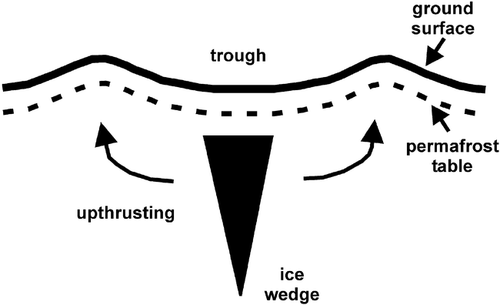
FIGURE 2. Schematic diagram indicating net outward movement of the active layer and subadjacent permafrost from polygon centers towards the bounding ice-wedge troughs. The figure is based on work by CitationMackay (1980, Citation1993, Citation1995, Citation2000)

FIGURE 3. Aerial photograph of spruce forests underlain by ice-wedge polygons, southern Mackenzie Delta. Well-developed polygonal patterns occur in the center and lower center of the photograph. Note the absence of spruce trees from the centers of well-defined polygons. Aerial photograph A22936-103 ©1972, Her Majesty the Queen in Right of Canada, reproduced from the collection of the National Air Photo Library with permission of Natural Resources Canada
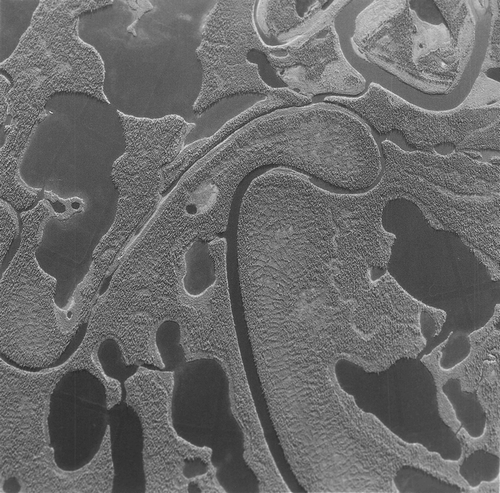
FIGURE 4. A spruce/feathermoss forest (Site 1) underlain by incipient ice-wedge troughs, southern Mackenzie Delta. The trees lean in random directions and are tilted at varying degrees. Many of these trees are anchored in permafrost. Deadfall is abundant
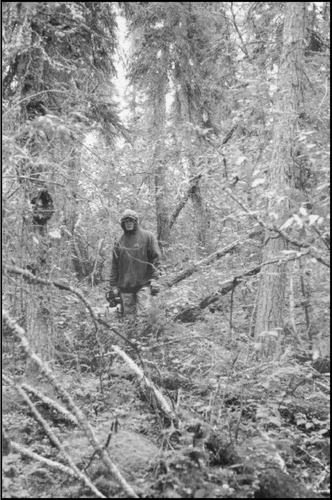
FIGURE 5. Eastern Mackenzie Delta, indicating study sites 1 to 5. The four small dots indicate additional sites where trees leaning into ice-wedge troughs were observed
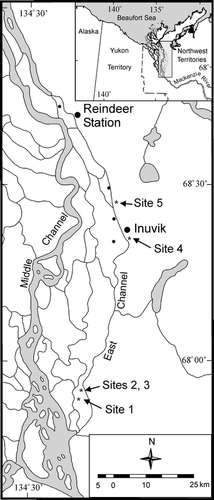
FIGURE 6. Maps of incipient ice-wedge networks and white spruce trees growing within 5 m of the ice-wedge trough, Sites 1 to 4, Mackenzie Delta. Circles proportional to tree circumference indicate tree position and arrows indicate direction of tree lean. The tree tilt (°) is indicated next to the tree
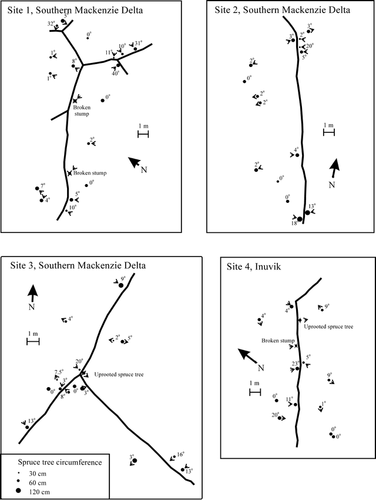
FIGURE 7. Trunk cross-section of a white spruce tree that was leaning into an incipient ice-wedge trough, southern Mackenzie Delta, Site 3. The tree was 255 yr old. There were 4 distinct periods of tilting and the mean change in orientation between successive periods was 4°. The mean duration of reaction-wood growth between periods of normal-ring growth was 31 yr
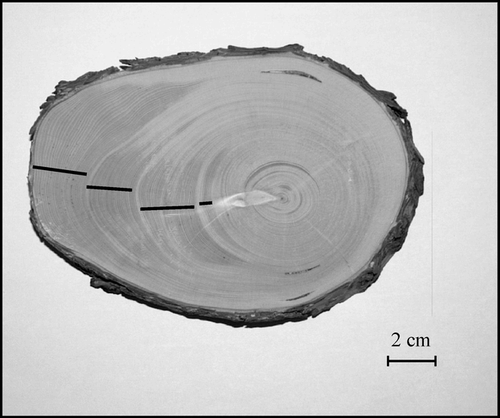
FIGURE 8. Tree to ice-wedge trough distance and angle of tree lean, Sites 1 to 4, eastern Mackenzie Delta. Shaded diamonds (♦) indicate that tree lean is towards the ice-wedge trough and open diamonds (⋄) indicate no lean or lean away from the ice-wedge trough
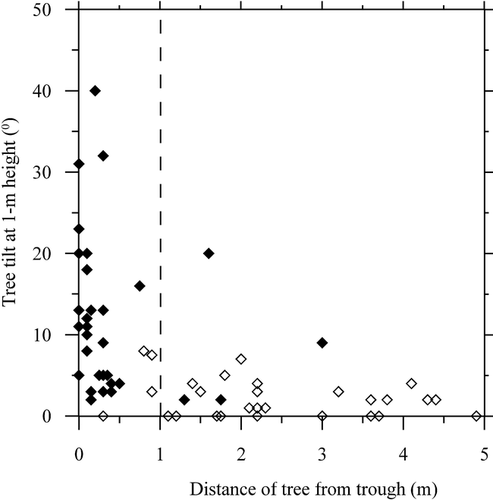
FIGURE 9. A) Two white spruce trees leaning across an ice-wedge trough near Site 1, southern Mackenzie Delta. The dashed line indicates the ice-wedge trough. Roots, indicated by an arrow, trail away from the ice-wedge trough. The lean at 1-m height of trees A and B was 25° and 18°. B) The exposed root system of a toppled white spruce adjacent to an ice-wedge trough near Site 4, Mackenzie Delta. All major roots extend away from the trough. The dashed line indicates the ice-wedge trough
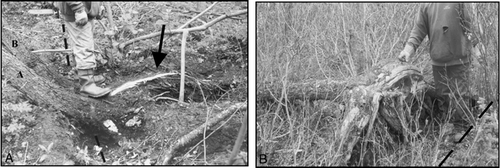
FIGURE 10. Periods of reaction-wood production in 14 white spruce trees growing adjacent to ice-wedge troughs, Sites 1 to 3 and 5, Mackenzie Delta. Thick lines indicate tilting within ±45° of the perpendicular from the tree to the adjacent trough, and thin lines indicate tilting away from the adjacent trough. The first year of tree growth is indicated by a single square

FIGURE 11. Polar plots of cumulative years of reaction wood with respect to orientation for leaning trees adjacent to ice-wedge troughs. Data are presented for three trees (tree 1—□; tree 2—•; tree 3—♦) from three areas in Mackenzie Delta. A) Site 1, B) Sites 2 and 3; and C) Site 5. Tangents indicate the approximate orientation of ice-wedge troughs with respect to the leaning trees
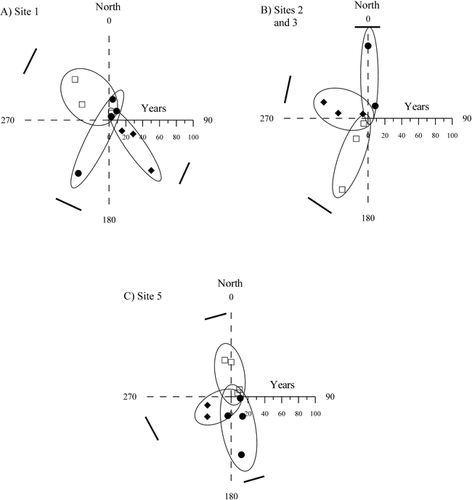
TABLE 1 Summary statistics for the absolute tilt of trees (°), irrespective of direction of lean, less than or equal to, and greater than 1 m from ice-wedge troughs mapped at Sites 1 to 4, Mackenzie Delta
TABLE 2 Age, periods of reaction-wood production, duration of reaction-wood growth, change in orientation between successive periods of leaning, and average rate of tilting for individual white spruce at ice-wedge sites in eastern Mackenzie Delta (Sites 1 to 3 and 5)
Acknowledgments
This work has been supported by the Natural Sciences and Engineering Research Council of Canada, the Northern Science Training Program of Indian Affairs and Northern Development Canada, the Aurora Research Institute, and the Polar Continental Shelf Project, Natural Resources Canada. Field assistance by Douglas Esagok and logistical support from Les Kutny is gratefully acknowledged. Facilities at the Taiga Environmental Laboratory, Yellowknife, were provided through the good offices of Bill Coedy, Indian Affairs and Northern Development Canada, Anne Wilson, Environment Canada, and Brett Elkin, Government of the Northwest Territories. Office logistical support in Yellowknife was provided to S. V. Kokelj through the generosity of Hal Mills, GeoNorth Ltd and David Milburn, Indian Affairs and Northern Development Canada. Christine Earl drafted and and Phillip Wilson drafted . Helpful comments on the manuscript were provided by S. A. Kokelj, E. Kotler, J. R. Mackay, Y. Shur, A. Smith, C. Tarnocai, and an anonymous reviewer. Polar Continental Shelf Project Contribution No. 00503.
References Cited
- Black, R. A. and L. C. Bliss . 1978. Recovery sequence of Picea mariana – Vaccinium uliginosum forests after burning near Inuvik, Northwest Territories, Canada. Canadian Journal of Botany 56:2020–2030.
- Burn, C. R. 1990. Implications for paleoenvironmental reconstruction of recent ice wedge development at Mayo, Yukon Territory. Permafrost and Periglacial Processes 1:3–14.
- Gill, D. 1975. The influence of white spruce trees on permafrost-table microtopography, Mackenzie River delta. Canadian Journal of Earth Sciences 12:263–272.
- Kokelj, S. V. and C. R. Burn . 2003. “Drunken Forest” and near-surface ground ice in the Mackenzie Delta, Northwest Territories, Canada. In: Proceedings of the 8th International Conference on Permafrost, 2003, Zurich, Switzerland. Rotterdam: Balkema, 567–571.
- Kotler, E. and C. R. Burn . 2000. Cryostratigraphy of the Klondike “muck” deposits, west-central Yukon Territory. Canadian Journal of Earth Sciences 37:849–861.
- Lachenbruch, A. H. 1962. Mechanics of thermal contraction cracks and ice-wedge polygons in permafrost. Geological Society of America, Special Paper, 70. 69 pp.
- Landhäusser, S. M. and R. W. Wein . 1993. Postfire vegetation recovery and tree establishment at the Arctic treeline: climate-change-vegetation-response hypotheses. Journal of Ecology 81:665–672.
- Mackay, J. R. 1963. The Mackenzie Delta Area, N.W.T. Geographical Branch, Mines and Technical Surveys, Ottawa, Memoir, 8. 202 pp.
- Mackay, J. R. 1974. Ice-wedge cracks, Garry Island, Northwest Territories. Canadian Journal of Earth Sciences 11:1366–1383.
- Mackay, J. R. 1980. Deformation of ice-wedge polygons, Garry Island, Northwest Territories. Current Research, Part A, Geological Survey of Canada Paper 80–1A:287–291.
- Mackay, J. R. 1989. Ice-wedge cracks, western Arctic coast. The Canadian Geographer 34:365–368.
- Mackay, J. R. 1990. Some observations on the growth and deformation of epigenetic, syngenetic and anti-syngenetic ice-wedges. Permafrost and Periglacial Processes 1:15–29.
- Mackay, J. R. 1992. The frequency of ice-wedge cracking (1967–1987) at Garry Island, western Arctic coast, Canada. Canadian Journal of Earth Sciences 29:236–248.
- Mackay, J. R. 1993. Air temperature, snow cover, creep of frozen ground, and the time of ice-wedge cracking, western Arctic coast. Canadian Journal of Earth Sciences 30:1720–1729.
- Mackay, J. R. 1995. Ice wedges on hillslopes and landform evolution in the late Quaternary, western Arctic coast, Canada. Canadian Journal of Earth Sciences 32:1093–1105.
- Mackay, J. R. 2000. Thermally induced movements in ice-wedge polygons, western Arctic coast: A long-term study. Géographie physique et Quaternaire 54:41–68.
- Mackay, J. R. and W. H. Mathews . 1973. Geomorphology and quaternary history of the Mackenzie River valley near Fort Good Hope, N.W.T., Canada. Canadian Journal of Earth Sciences 26:26–41.
- Mackay, J. R. and C. R. Burn . 2002. The first 20 years (1978–1979 to 1998–1999) of ice-wedge growth at the Illisarvik experimental drained lake site, western Arctic coast, Canada. Canadian Journal of Earth Sciences 39:95–111.
- Osterkamp, T. E. , L. Viereck , Y. Shur , M. T. Jorgenson , C. Racine , A. Doyle , and R. D. Boone . 2000. Observations of thermokarst and its impact on Boreal Forests in Alaska, U.S.A. Arctic, Antarctic, and Alpine Research 32:303–315.
- Pearce, C. M. , D. McLennan , and L. D. Cordes . 1988. The evolution and maintenance of white spruce woodlands on the Mackenzie Delta, N.W.T., Canada. Holarctic Ecology 11:248–258.
- Péwé, T. L. 1966. Ice-wedges in Alaska—classification, distribution, and climatic significance. In: Permafrost International Conference 1963, Lafayette, Indiana. Washington: National Academy of Sciences–National Research Council, 76–81.
- Pihlainen, J. A. and G. H. Johnston . 1954. Permafrost investigations at Aklavik: 1953 (Drilling and Sampling). National Research Council, Division of Building and Research, Ottawa. Technical Paper, 16. 16 pp.
- Schroder Jr., J. F. 1978. Dendrogeomorphological analysis of mass movement on Table Cliffs Plateau, Utah. Quaternary Research 9:168–185.
- Scurfield, G. 1973. Reaction wood: its structure and function. Science 179:647–655.
- Smith, M. W. 1975. Microclimate influences on ground temperatures and permafrost distribution, Mackenzie Delta, Northwest Territories. Canadian Journal of Earth Sciences 12:1421–1438.
- Smith, M. W. 1976. Permafrost in the Mackenzie Delta, Northwest Territories. Geological Survey of Canada, Paper, 75–28. 34 pp.
- Viereck, L. A. 1973. Ecological effects of river flooding and forest fires on permafrost in the taiga of Alaska. In: Proceedings of the 2nd International Conference on Permafrost, 1973, Yakutsk U.S.S.R. Washington, D.C.: National Academy of Sciences Press, 60–70.
- Wolfe, S. A. , E. Kotler , and M. F. Nixon . 2000. Recent warming impacts in the Mackenzie Delta, Northwest Territories, and northern Yukon Territory coastal areas. Current Research, Geological Survey of Canada Paper, 2000-B1.
- Zar, J. H. 1999. Biostatistical Analysis. 4th ed. Englewood Cliffs, NJ: Prentice Hall. 147 pp.
- Zoltai, S. C. 1975. Tree ring record of soil movements on permafrost. Arctic and Alpine Research 7:331–340.
- Zoltai, S. C. and C. Tarnocai . 1974. Soil and vegetation of hummocky terrain. Environmental-Social Committee, Northern Pipelines, Task Force on Northern Oil Development. Report, 74–5. 86 pp.
